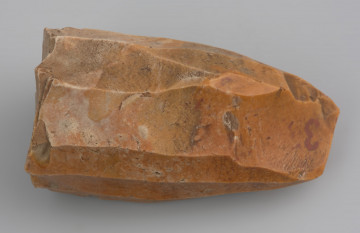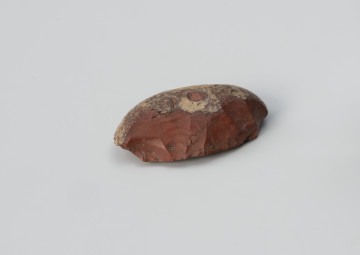
Conical chipboard core
7800 p.n.e. — 7000 p.n.e.
National Museum in Szczecin
Part of the collection: Stone Age
A Late Mesolithic single-platform sub-conical core was found in Biebrówek, the Goleniowski district, in 1954. It was initially thought to be a fragment of a Neolithic axe. The core is a shaped lump of flint used to extract half-finished chip or split material, which was later used to make various tools and weapon elements. There are several ways of using cores; in this case, the preserved traces indicate the use of an intermediary, most probably from antlers; the core was not struck directly, but the antlers were placed on it. The core from Biebrówek belongs to flat, tabular forms, which is the result of intensive exploitation. Originally, it was the so-called sub-conical specimen, with a circumference close to a circle, with a flat, natural back. The plane to which the intermediate was applied, the core heel is specially shaped with many short break-offs. The preparatory procedure for proper use is called heel freshening. Technological and morphological features indicate that the core should be associated with the Late Mesolithic. In the flint-making of Late Mesolithic communities, blades were produced using either an intermediary or the pressure method. The use of both techniques on a single core is not observed, unlike on specimens from the Middle Mesolithic period. In the Late Mesolithic, different cores were used to produce large intermediary blades and small pressure chips. The former ones were bounced from conical and sub-conical cores, while the latter stabilised in vice-like devices. The core from Biebrówka is an example of a highly depleted core for intermediate chip production. An almost identical specimen was found at Płocin on Wolin Island. In both cases, the cores have fresh heels. It is a characteristic feature of the Mesolithic in the eastern Baltic zone, borrowed from eastern areas in the 8th millennium BC.
Michał Adamczyk
Author / creator
Dimensions
cały obiekt: height: 3.1 cm, width: 4 cm
Object type
lithic core, production waste
Technique
intermediary, carving, hard masher carving
Material
flint, stone
Origin / acquisition method
field research
Creation time / dating
Creation / finding place
Owner
National Museum in Szczecin
Identification number
Location / status

7800 p.n.e. — 7000 p.n.e.
National Museum in Szczecin

7800 p.n.e. — 2000 p.n.e.
National Museum in Szczecin

12700 p.n.e. — 11500 p.n.e.
National Museum in Szczecin
DISCOVER this TOPIC
National Museum in Szczecin
DISCOVER this PATH
Educational path